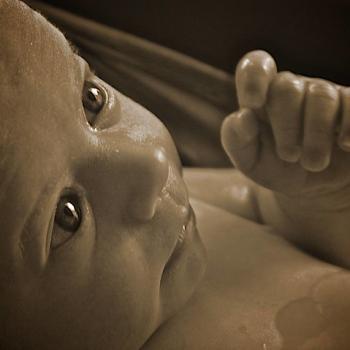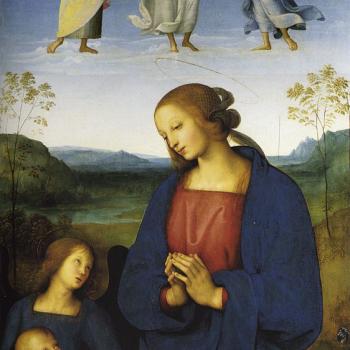Now Featured in the Patheos Book Club
Christian Mystics: 108 Seers, Saints and Sages
By Carl McColman
Lovers
"God is love" (I John 4:16) may be the single most important verse in the entire Bible. Many things have been said about God, both in scripture and beyond: God is omnipotent, God is almighty, God is jealous, God is wrathful, God is forgiving, God is merciful, God is just, and so forth. But God is love always seems to win out as the single most essential piece of information about the Divine. Maybe "the fear of the Lord is the beginning of wisdom" (Proverbs 1:7, emphasis added), but the end of wisdom is surely the love of God, which is both given to us and received from us in turn.
With all this in mind, is it any wonder that many of the great Christian mystics are renowned as lovers of God? This can take a variety of forms: for some, being God's lover is very ethereal and philosophically abstract; but for others, an embodied, physical, even erotic quality characterizes their mysticism of love. There is even a term—"bridal mysticism"—for the many mystics (both female and male) whose experience of profound love of God was so deep and all-encompassing that it led to a spiritual sense of being "married" to God—or at least loving God with the same all-pervasive devotion that a bride and groom have for one another.
Before you decide that this kind of mysticism is just plain creepy, consider that this derives from the Bible itself. One of the loveliest books in the Hebrew Bible (the Old Testament) is the Song of Solomon, also called the Song of Songs or the Canticle of Canticles. It's a short book, only about three thousand words; but it is filled with lovely, poetic language about (what else?) love. It is the story of a bride and bridegroom, their passion for one another, their devotion to one another, and their (strongly hinted at) passion as physical lovers.
Historically, the Song of Songs has been read as a kind of allegory: the two lovers symbolize the caring relationship between God and Israel, or Christ and the Church, or Christ and the individual believer. This is where the mysticism of love comes in: for the mystics, the power and splendor of their intimacy with God are so great that the only earthly love that even comes close to describing it is the love between a husband and wife.
In thinking about your encounter with God's love, erotic or marital imagery may or may not work for you. But even if this analogy leaves you cold, try to imagine the power of God's love and how it can set a mystic's heart aflame with passion, longing, and desire. This will give you some insight into the earthy devotion that infused the mystics of love.
Beatrice of Nazareth (ca. 1200–1268)
Beatrice of Nazareth was the youngest child of a devout Flemish family; her father may have been a mason involved in the construction of three different monasteries. After her mother's death when she was seven, Beatrice lived for a year with Beguines (Christian lay women who lived communally). Afterward she went to live with nuns, and even as a child she began to engage in severe ascetic practices, including fasting and self-denial.
As a teen, her superiors sent her to a neighboring convent to learn the art of manuscript writing. At this time she met Ida of Nivelles, who was only a year older than Beatrice but already renowned as a mystic. Forming a close bond with Ida, soon Beatrice, at age sixteen, received her own ecstatic vision—of the Trinity, the heavenly Jerusalem, and choirs of angels. After the vision, Beatrice reacted with profound emotion: she sobbed when she realized her ecstasy had ended, but she also felt such immense gratitude that she laughed out loud. After a short period of happiness, she fell into a state of fatigue and inertia; Beatrice's religious observance became slack for several months. After receiving a letter from Ida in which she encouraged her friend to take communion, Beatrice began to reintegrate herself into the religious observance of convent life. From here, the youth began to understand that the spiritual life was not about making demands of God; and that extreme acts of asceticism or self-denial could be harmful rather than sanctifying.
As a young adult, Beatrice immersed herself in the ordinary life of a nun, studying scripture, striving to grow in virtue, and participating in the spiritual exercises of her religious community. She struggled to cleanse herself of her sins but came to see that penance or asceticism did more harm than good. She also tried to motivate her quest for holiness through willfully forcing herself to be more grateful and loving—but she naturally discovered that such headstrong actions could not achieve the sanctity she desired. Distraught, Beatrice prayed to God for help—and in response realized that God wanted her to affirm her soul's innate beauty. She realized that God gives all people natural virtues, in different measures to each soul. Seeing that her soul contained its own beauty, and that furthermore each person is unique, liberated Beatrice to follow the path of sanctity given to her alone by God—which is to say, to become holy by being true to her own unique gifts and virtues. But this insight did not mark the culmination of Beatrice's journey. After several years of relative peace and stability in her life as a nun, another long season of depression and inner turmoil returned. She was beset by fear that she might lose her faith or succumb to sinful thoughts and temptations. Yet she also received the insight that even her struggles could be a gift—a way God could train her for greater holiness.




